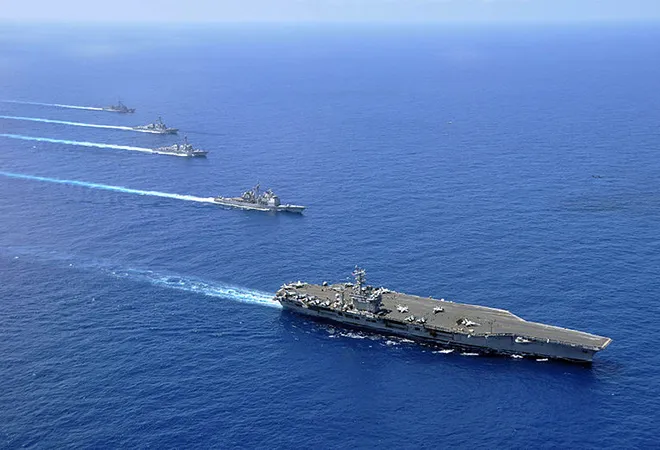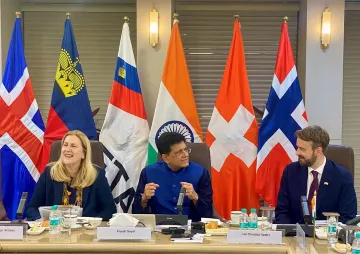THE ISSUE: South China Sea - Nearing boiling point?
With the start of the Presidency of Donald Trump in the US, tensions between the US and China received a fresh spark when the new US Secretary of State , Rex Tillerson, commented that the Trump government should do the needful in keeping China’s in the South China Sea actions limited. Tillerson made the comments at his confirmation hearing before the US Senate foreign relations committee stating that “
first the island buildings stop and second, your access to those islands is also not going to be allowed.” He spoke specifically about Beijing’s island building and land reclamation activities in recent months and even compared them to Russian annexation of Crimea. Beijing’s increasing presence in the reefs and land formations in the South China have fuelled apprehensions among littoral countries of the region, almost all of whom have overlapping maritime territorial claims with China. But Tillerson’s comment is perhaps the first instance of a major power bluntly classifying China’s actions as beyond its sovereign scope and articulating the intent of curbing such actions.
When concerns regarding China’s maritime actions are voiced, the official response is a routine one,
stating that its movements are well within its sovereign rights. This time however, the response was markedly two-pronged. While the official statement was customary, the Chinese media was more vocal and cautioned against any forward action by the US. Chinese newspapers rubbished Tillerson’s remarks as being
naïve and shortsighted and even threatened confrontation should the US government continue to reiterate this position. The current political dispensation in the US does not appear to be one that will back down. Tillerson also remarked that China’s activities continue to expand because there has been no credible challenge and no one to call out the nation for its maritime movements.
There is, at the moment, a sense of confused disbelief regarding the Secretary of State’s comments with many assuming that it is merely aggressive rhetoric. On the other hand, there is also a sense of suspicion driven by the fact that the Trump government appears to many as unpredictable and by extension, likely to follow up its rhetoric with actions.
Many commentators also believe that both countries need to realize that their economic and political relations are more expansive than maritime engagements in the South China Sea. Nevertheless, it may take a while to know how US policy in the Asia Pacific will shape up under the new government, but the initial signals suggest that policy shifts are likely. This may trigger new political arrangements that might change the status quo of maritime politics in the region, though military engagement still seems unlikely.
MEDIA WATCH
US Ambassador says America not building arms depot in Philippines
The United States is not building any weapons depot anywhere in the Philippines, the US ambassador said, denying the basis on which President Rodrigo Duterte threatened to abrogate a 2014 defense pact that allows US forces to temporarily base in local camps. Ambassador Sung Kim said that nothing is being planned now that even closely resembles a weapons depot.
Source: The Indian Express
Philippines' Duterte asks China to patrol piracy-plagued waters
Philippine President Rodrigo Duterte said he had asked China to help in the fight against Islamic State-linked militants by sending ships to patrol southern waters plagued by raids on commercial vessels.A surge in piracy off parts of the Philippines is forcing ship-owners to divert vessels through other waters, pushing up costs and shipping times.
Source: Reuters
China steps up preparedness for possible military conflict with US
China is stepping up preparedness for a possible military conflict with the US as the Donald Trump presidency has increased the risk of hostilities breaking out, state media and military observers said. Beijing is bracing itself for a possible deterioration in Sino-US ties, with a particular emphasis on maritime security. The People’s Liberation Army said in a commentary on its official website last Friday, the day of Trump’s inauguration, that the chances of war have become “more real” amid a more complex security situation in Asia Pacific.
Source: South China Morning Post
3rd US-China clash on South China Sea since Donald Trump takeover
China and the US took opposite positions on one more issue, making it the third, since Donald Trump took over as US president last Friday. Chinese foreign ministry warned Washington to "speak and act cautiously" on the South China Sea. The two countries earlier clashed on Taiwan and trade issues. White House press secretary, Sean Spicer sparked off the South China Sea controversy saying the US would "make sure that we protect our interests" in the resource-rich trade route, through which $4.5 trillion worth of trade passes each year.
Source: The Times of India
China to firmly defend sovereignty over South China Sea
As Trump administration fired its first salvo to counter China’s island building in disputed South China Sea, a perturbed Beijing hit back saying it will firmly safeguard its “indisputable sovereignty” irrespective of what America says. The comments came hours after White House Press Secretary Sean Spicer issued a stern warning to China, saying the US will protect its interests in the SCS and defend international territories from being taken over by “one country”. This is first direct comment by Trump administration after the tough talking billionaire took over as President on Friday, signalling an assertive policy on the SCS contrary to a cautious policy pursued by Obama administration.
Source: The Indian Express
China calls for integrated Asia-Pacific
China has responded to US President Donald Trump’s withdrawal from the Trans-Pacific Partnership (TPP) by reiterating its commitment to economic integration in the Asia-Pacific region.Trump followed through on a campaign promise he had been making for months and signed an executive order to withdraw from the TPP, which had been a cornerstone of Barack Obama’s policy to counter China’s growing global influence.
Source: The BRICS Post
Abe pledges fresh security-related aid to Vietnam
Prime Minister Shinzo Abe said that Japan will provide six patrol vessels to Vietnam as a part of a fresh yen loan offer totaling ¥120 billion to the Southeast Asian country to help its maritime safety efforts amid China’s expanding activities at sea. The patrol vessels are aimed at enhancing bilateral cooperation, Abe said at a news conference following talks with his Vietnamese counterpart, Nguyen XuanPhuc, in Hanoi, held at a time when uncertainty is looming over incoming U.S. President Donald Trump’s commitment to the stability of the Asia-Pacific region.
Source: The Japan Times
China and Vietnam to 'manage' differences over South China Sea: communique
China and Vietnam pledged to manage their differences and safeguard peace in the South China Sea, in a joint communique issued during a visit to China by Vietnamese Communist Party chief Nguyen PhuTrong. After "candid" discussions, the two countries agreed to "manage well their maritime difference, avoid actions that complicate the situation and escalate tensions, and safeguard the peace and stability of the South China Sea", said the communiqué. In the joint communique the two sides agreed to continue to "fully and effectively" implement the Declaration on the Conduct (DOC) of Parties in the South China Sea and strive for the early conclusion of a Code of Conduct (COC) on the basis of consensus in the framework of the DOC.
Source: Reuters
China tests aircraft carrier's capabilities in South China Sea
China's first aircraft carrier formation which moved close to Taiwan and conducted drills in the disputed South China Sea has returned to Qingdao port after finishing exercises and testing combat-capability, the Chinese navy has said. Comprised of aircraft carrier Liaoning, a number of destroyers, some J-15 carrier-based fighter jets and helicopters, the fleet sailed through the Bohai Sea, the Yellow Sea, the East China Sea and the South China sea, it said. The Chinese navy said J-15 fighter jets on board the carrier carried out exercises including taking off and landing in different hydrological and meteorological conditions, air-combat tactics, air refuelling, and others.
Source: The Times of India
Chinese media warns of clashes with the US over South China Sea
Is the US planning a large-scale war on China, the state media taunted after US secretary of state-nominee Rex Tillerson said the new government in Washington should prevent China’s access to islands built by Beijing in the South China Sea. Speaking during his confirmation hearing before the US Senate foreign relations committee, Tillerson said the new US administration will send a clear signal to China that “first the island buildings stop and second, your access to those islands is also not going to be allowed”. Tillerson said China's island-building in the South China Sea was similar to “Russia's taking of Crimea”.
Source: Hindustan Times
RECENT PUBLICATIONS
BOOKS
Dr. D.N. Roy, “The South China Sea A Sea of Disputes”, Neha Publishers & Distributors, 2017
COMMENTARIES
Amitai Etzioni, “Tillerson, Trump and the South China Sea”, The Diplomat, January 28, 2017
BecStrating, “Timor-Leste’s maritime ambitions risk all”, East Asia Forum, January 28, 2017
Samir Tata, “China's Maritime Great Wall in the South and East China Seas”, The Diplomat, January 24, 2017
Bernard Miranda, “Warning at Sea: Be Prepared, Be Ready”, RSIS, January 24, 2017
Jim Steinberg and Michael O'Hanlon, “Can Donald Trump Avoid a Dangerous South China Sea Showdown?”, The National Interest, January 18, 2017
J. Berkshire Miller, “As Trump era looms, Beijing fortifies the South China Sea”, The Japan Times, January 15, 2017
Editor: K. Yhome
Associate Editor: Pratnashree Basu
The views expressed above belong to the author(s). ORF research and analyses now available on Telegram! Click here to access our curated content — blogs, longforms and interviews.




 PREV
PREV

